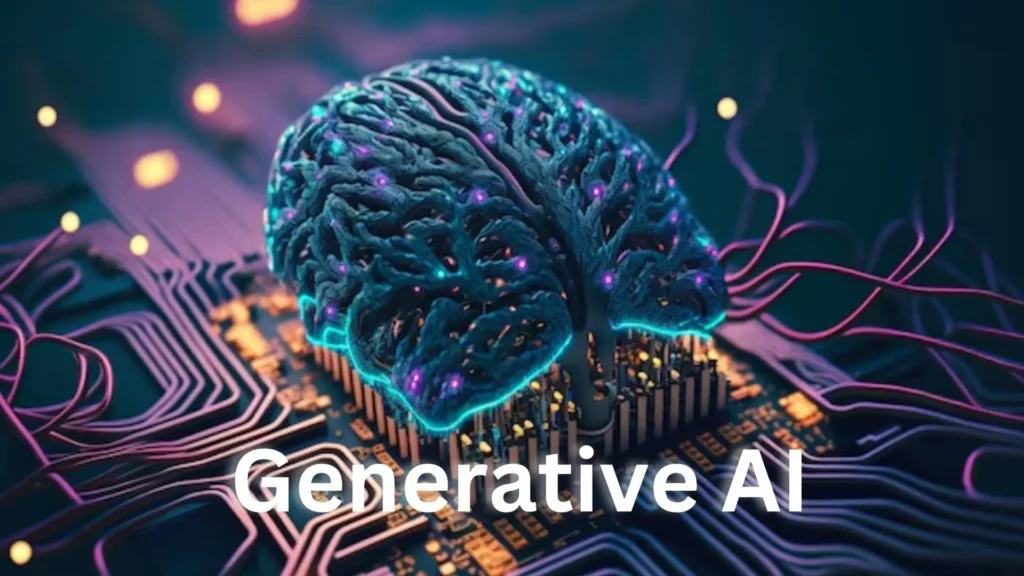Imagine a world where machines can paint masterpieces, write gripping novels, or design groundbreaking products—all in seconds. Generative AI is changing the way we work, create, and solve problems. Generative AI offers businesses the ethical and technical challenges it brings and what the future holds for this game-changing tech. This blog explores how Generative AI works, its potential, real-world uses, risks, and what the future may hold for businesses.
Table of Contents:
What is Generative AI?
Generative AI (GAI) is a type of technology that can create new things like text, images, music, code, videos, and more. It uses smart computer programs called algorithms to learn from lots of data and then generate original content that looks or sounds like it was made by humans. It uses sensory networks (systems inspired by the brain) to analyze data and generate original outputs. For example, if you give them thousands of pictures of cats, they learn what a cat looks like and can then create new, realistic cat images that never existed before.
Generative AI is not new, and it started as early as the 1950s with models that created speech patterns. Early models used math and probability to predict words in a sentence. Later, deep learning and better models like RNNs (Recurrent Neural Networks) improved the results.
Key Points:
- Generative AI includes tools like ChatGPT, DALL·E, Mid-journey, and Bard.
- It is used to create things like stories, art, music, code, and videos.
- These models use neural networks to learn from data and make new content.
- As models get bigger and learn from more data, they create more realistic and high-quality results.
Opportunities of Generative AI

Generative AI (GAI) is opening many new ways for businesses, workers, and even students. It is helping different industries become faster, smarter, and more creative. It unlocks huge opportunities across industries by increasing efficiency, creativity, and decision-making. It automates tasks, personalizes experiences, and creates new content, driving economic growth and innovation. Here’s a simple breakdown of the big opportunities:
Sector-Wise Opportunities in India
✅ Agriculture
- AI helps with crop planning, pest control, and water usage.
- It can also predict climate issues and suggest the best farming practices.
- Tools: Ama KrushAI, Kissan GPT
✅ Education
- AI creates personalized lessons, auto-generates quizzes, and offers virtual tutoring.
- It can restore old learning materials and help teachers prepare content.
- Tools: NOLEJ, TutorAI, Snapxam.
✅ Healthcare
- AI assists in diagnosis, speeds up drug discovery, and reduces medical errors.
- It helps create personalized treatment plans.
- Tools: MedPaLM, Viz.ai, CloudMedX
✅ Manufacturing
- Speeds up product design, quality control, and customer support.
- Helps manage supply chains and production issues.
- Tools: Autodesk, BirlaSoft, FortiSandbox
✅ Retail
- AI gives product suggestions, tracks inventory, and sets prices smartly.
- It builds chatbots and fights fraud.
- Tools: Market360, Scan unlimited
✅ Media & Entertainment
- Creates blogs, social media posts, and videos.
- Adds local language dubbing using deepfake tech.
- Helps with VFX and upscaling visuals.
- Tools: Copy.ai, Lately, Amplify
✅ Marketing
- Can clone voices, customize ads for local languages, translate campaigns and target niche audiences.
- Great for reaching people in different languages and even preserving memories.
Opportunity of Generative Ai in Various Places
1. Applications & Services
- Most money and innovation are in creating AI apps and offering AI services.
- Startups and businesses can build tools for education, farming, medicine, or retail.
- Many enterprises are already putting Generative Ai to use.
2. Entrepreneurship
- Open tools and cloud access make it easier for small businesses to start using AI.
- Anyone with an idea can build apps using foundation models like ChatGPT.
3. Creative Industries
- GAI helps create music, videos, art, and writing.
- India’s creative space, like film and media, can grow with AI.
4. Technical Power
- AI can turn regular people into 10x developers, boosting the tech industry.
- It helps teams build apps, write code, and test ideas faster.
5. Data Advantage
- India has a huge amount of data. AI tools can help turn it into smart solutions.
Challenges of Generative AI

Generative AI is a powerful tool, but like any new technology, it brings challenges. These include misinformation, bias, legal concerns, ethics, and regulation issues. Here’s a breakdown of the main problems:
1. Misinformation and Fake Content
- AI can create false or misleading content like fake news articles, images, videos (deepfakes), or audio.
- This false content can spread quickly on social media and create confusion, fear, or even political and social disturbance.
- One big issue is called “hallucination”, where AI tools like ChatGPT give confident but incorrect answers.
- Example: Deepfakes have been used to manipulate political opinions or cause social unrest.
2. Bias in AI Models
- AI models often reflect human biases from their training data. For example, if the data is biased, favouring certain countries, races, or genders, the AI becomes biased too.
- These biases can lead to unfair results, discrimination, or cultural exclusion.
- Example: Midjourney generated images of “popular leaders”; it showed only Western leaders and ignored others like Asian or African leaders.
3. Legal and Copyright Issues
- Many AI models are trained using content (books, art, music) that may be protected by copyright laws.
- Copyright laws are unclear, especially for works made using tools like ChatGPT or DALL-E.
- There is also confusion about whether AI can be listed as a co-author in scientific papers or creative works.
- AI training often uses copyrighted material without permission, bringing legal problems.
4. Ethical Concerns
- Generative AI can be used for good or harm, depending on who is using it and how.
- It can impact:
- Jobs: Automation may replace human work.
- Creativity: AI-generated art or writing may reduce the need for human creators.
- Privacy: AI could use personal data without permission.
- There is also fear of AI causing physical harm (e.g., medical errors); it is unclear who’s responsible—developers, users, or the AI itself?
5. Lack of Transparency
- Many AI systems are not fully open about how they work or what data they were trained on.
- This makes it hard to:
- Understand how AI makes decisions.
- Identify and fix errors or biases.
- Trust the results generated by AI.
- Even experts sometimes don’t fully understand the inner workings of these large models.
6. Regulatory Challenges
- Countries are still figuring out how to regulate AI in the right way.
- The European Union’s AI Act focuses on protecting users and preventing harm.
- China wants to ensure state control and content safety.
- The U.S. AI Bill of Rights promotes data privacy, fairness, and user control.
- Global regulation is tricky because every country has different priorities.
- There’s also concern that only big tech companies have enough data and computing power to train these models, leading to monopolies.
7. Responsibility and Accountability
- There are four major groups involved in using AI:
- Developers – who build the models.
- Deployers – who adapt and implement the models.
- Users – individuals or companies who use the tools.
- Recipients – people who receive and use the outputs.
- If something goes wrong, it’s often unclear who is responsible.
- That’s why we need clear rules, AI audits, and ethical training for developers.
Future of Generative AI for Professionals
- Job Impact: Generative AI may affect up to 300 million jobs worldwide. It can replace around 25% of current work in the US and Europe.
- New Job Roles: While some jobs may go, new types of jobs will also be created, especially those using AI tools.
- Humans Still Needed: AI still needs human input and correction. It cannot fully work on its own yet.
- Boosts Efficiency: AI helps people do tasks faster and better, saving time.
- Big Changes in Work: About 80% of U.S. workers might see 10% of their tasks affected by AI. For 15% of tasks, AI can help finish them faster without lowering quality.
- Creative or Just Generative: AI tools like DALL·E and Midjourney use existing data to make new things. Some experts say this is not true creativity—it’s just mixing old ideas in new ways. Humans still have the edge in original thinking.
- Growing Role: Over time, AI may move from inference-based to memory-based learning, becoming more powerful.
- Big Potential: If used well, Generative AI can make work easier, faster, and even more fun.
Conclusion
Generative AI is more than just a tech trend. It is a powerful tool changing the future of industries. While it offers faster work, smarter solutions, and new business opportunities, it also comes with risks like mis-information, bias, and job fear. The risks—from deepfake scandals to biased algorithms—remind us that innovation without responsibility is a recipe for chaos. It’s here to challenge us—to think smarter, act bolder, and build a future. With the right approach, Generative AI can become a trusted partner for innovation and growth. The question is not that you are using Generative AI, but how wisely you use it.



